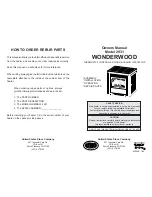
Draught
The draught of the stove is essential to have good performances in specific adverse weather conditions
(rain, fog, snow, altitude, cold, wind), and it is conditioned by the position of the flue. Adverse weather
conditions that affect negatively the draught are various; particularly burdensome is the wind, which can be:
ascending, horizontal, descending.
-
Ascending wind: increases the depression and consequently the draught.
-
Horizontal wind: it increases the depression, only in the case of a right installation in the direction of
the wind.
-
Descending wind: decreases the depression and consequently the draught.
The flue, if placed in the upwind side, increases the overpressure and consequently, in the opposite
situation, increases the depression, decreasing the draught.
To overcome these drawbacks, the installer must act directly on the stove, modifying the parameter to
adjust the speed of fume extraction and verify all safeties. This operation is particularly delicate, it must
always be carried out by authorized personnel. The ZF company declines any liability, whether civil or
criminal, for missed control by the installer of all safeties.
Distances and positioning
Roof inclination
Distance between the peak
and the chimney
Minimum height of the chimney
(Measured from the block)
β
A
H
15°
<1,85
50 centimeters beyond the top
>1,85
1 meter from the roof
30°
<1,5
50 centimeters beyond the top
>1,5
1,3 meters from the roof
45°
<1,3
50 centimeters beyond the top
>1,3
2 meters from the roof
60°
<1,2
50 centimeters beyond the top
>1,2
2,6 meters from the roof
Summary of Contents for Euro Alpi Vezzana
Page 1: ...Use and maintenance manual for pellet stove...
Page 42: ...16 Notes...
Page 43: ...Notes...













































